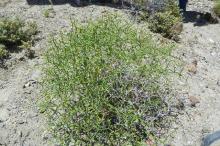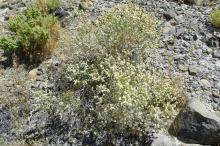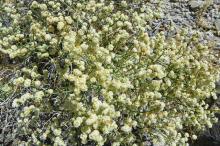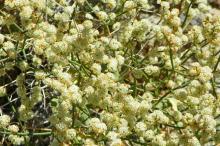Eriogonum heermannii var. humilius is a domed airy shrub of the sagebrush and saltbrush comunities in the Great Basin. Found growing in the moderatly deep sandy deposites of arroyas and drainages.The bright green stems are heavily branched at all the nodes and the few leaves it has, are located on the lower branches. They drop off early in the heat of summer giving it a stark skeletal appearance. From a distance it looks like a thorny desert dweller. When you give it a closer inspection you realize that it is not armed with spines, just stiff tapered twigs. The plants I have seen are from 12-30 inches tall and as wide as they are tall. They bloom in July opening most of the flowers in a week long flush. As the flowers ripen their seed the flower heads turn a copper color as they desiccate. A dramatic shrub no matter the season.
I have collected seed and hope to grow this in my dry garden.
http://www.calflora.org/cgi-bin/species_query.cgi?where-calrecnum=3265
http://www.efloras.org/florataxon.aspx?flora_id=1&taxon_id=250060311
Comments
Re: Eriogonum heermannii var. humilius
Mark
What a great description!!
the "cage" of bare divaricating stems
Such a word smith. :D
Wish I had taken my camera when I went to collect seed. It was just one more thing to lug around in the heat and I was on a mission to collect seed from several genera that inhabit the area. I will make a point of getting some shots next July. I had never seen it with ripe seed before so didn't know what to expect. It was impressed.
When I saw it in full bloom the numbers and variety of pollinators blew me away. Flies, moths, beetles, butterflies, wasps, bees, and hover flies were vying for their portion of nectar. Not just one species of each genus but several. The vatiety of pollinators that use Eriogonums always amazes me.





John, keep us posted on the progress of your seedlings. The genus is sooOOOO interesting with weird desert and tumble weed manifestations. I don't imagine such species would be very growable here, but when the "cage" of bare divaricating stems flower it is actually quite pretty.
Do you know of any photos of this species when the flowers age to a copper color, that must be an amazing sight. Wow, 8 varieties of this species, seems that Eriogonum taxonomy is always diverse and difficult.